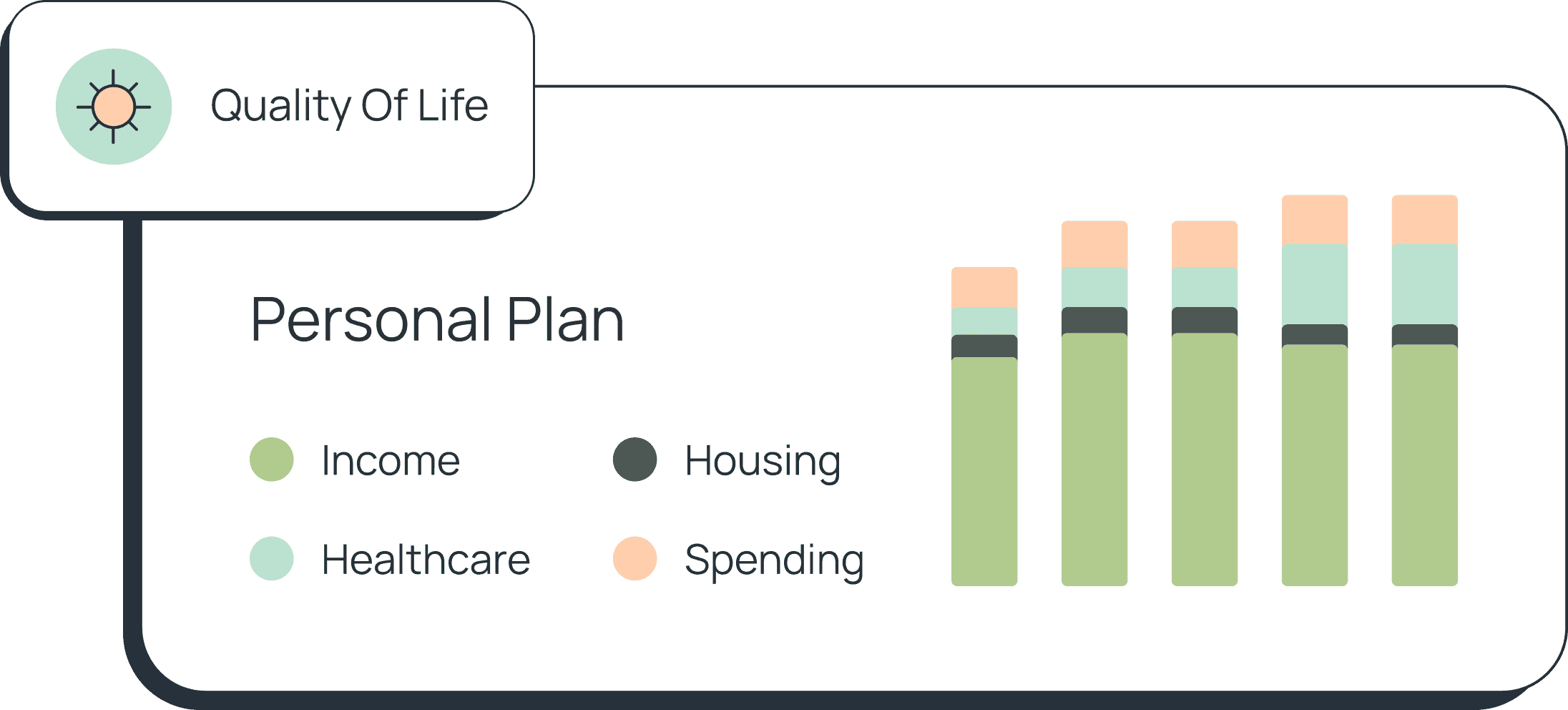Retirement Accounts
Being your own boss means you set most of the rules, but it also means you need to take care of administrative tasks that companies usually do for you, including opening and contributing to your own retirement plan—as well as the plans of your employees, if you have any. Luckily, there are several different retirement plans for self-employed people, each with their own pros, cons, and contribution rules.

C.E Larusso
•
Published April 25th, 2024
•
Updated February 6th, 2025
Table of Contents
Key Takeaways
Choose a self-employed retirement plan that suits your business size and how many employees you have
Traditional IRAs, Roth IRAs, and Solo 401(k) plans are excellent for those with no employees
The SIMPLE IRA is best suited for those with 100 or fewer employees
Check the contribution limits and tax implications of each plan to ensure you’re able to meet your retirement goals
Self-Employed Retirement Plans to Consider
Being your own boss means you set most of the rules, but it also means you need to take care of administrative tasks that companies usually do for you, including opening and contributing to your own retirement plan—as well as the plans of your employees, if you have any. Luckily, there are several different retirement plans for self-employed people, each with their own pros, cons, and contribution rules.
Best Self-Employed Retirement Plans
As a self-employed person, you’ll likely be choosing between a traditional or Roth IRA, a solo 401(k), a SEP IRA, a SIMPLE IRA, or a defined benefit plan. Some of these are better choices when you have employees, while others cater to those who have zero or no employees. Learn the differences between them to ensure you’re choosing the best for your business and income level.
Traditional or Roth IRA
IRA Contribution Limit: $7,000 in 2025 ($8,000 if age 50 and older); read more details on the IRS’ website.
Best for: Those just kicking off their retirement plans or people who are moving from a employer-sponsored plan to start a business or become a freelancer.
Tax Benefits: Tax deductions allowed on traditional IRAs; with Roth IRAs, no deductions allowed because withdrawals during retirement are tax-free.
IRA Overview
If you’re just getting started, an individual retirement account (IRA) is probably one of the best self-employed retirement plans you can find. They’re especially beneficial to those leaving the workforce to freelance, since you can roll over an employer-provided 401(k) into an IRA.
For the self-employed, IRAs are typically offered in two major types: traditional and Roth. With a traditional IRA, you can deduct your contributions on your taxes, which makes it a great option for socking some of your earnings away that you would otherwise give to the IRS. However, you’re only deferring taxes until retirement. With a Roth IRA, you can’t deduct the money you put in, but the benefit is that you can enjoy tax-free withdrawals when you retire.
How to start contributing to a self-employed IRA: Many online brokers allow you to sign up for and open an IRA in as quickly as 30 minutes; choose from places such as Fidelity, E*TRADE, Wealthfront, and J.P. Morgan.
Contribution rules if you employ workers: None;
Solo 401(k)
401(k) Contribution Limit: In 2024, the contribution limit is the lesser of $69,000 (with a catch-up contribution of $7,500 for those 50 and older) or 100% of your earned income.
Best for: Business owners and self-employed people without employees (except spouses, when applicable)
Tax Benefits: As a 401(k), your contributions are made with pretax dollars and retirement withdrawals will be taxed. You could opt for a solo Roth 401(k), which has the same tax as a Roth IRA—this could be a wise option if you expect your retirement income to be higher than your current income.
Solo 401(k) Overview
The IRS called the Solo 401(k) a “one-participant 401(k)”; it’s a good option for those who wish to save a high amount in some years with lower contributions in others. Here’s why: you, as a self-employed person, function as both the employer and the employee, so the contribution limits are higher.
In 2023, the contribution limit is the lesser of $69,000 (with a catch-up contribution of $7,500 for those 50 and older) or 100% of your earned income. Here’s how that breaks down:
- As the employee, you can contribute as you normally would to a 401(k), with up to 100% of your compensation deferred or $22,500, whichever is less
- As the employer, you can make an extra contribution of up to 25% of compensation
- If you are a sole proprietor or single-member LLC, you can contribute 25% of net self-employment income, or your net profit minus half of your self-employment tax and plan contributions you made for yourself
- The compensation ceiling you can use to calculate your contribution is $330,000 in 2025
You may not be eligible for large or small business retirement plans, but you still can participate in a solo 401(k) and save a lot of money given the structure of the contribution limits.
How to start contributing to a self-employed 401(k): Many online brokers offer solo 401(k) accounts; note that you’ll need to file paperwork with the IRS every year once you have over $250,000 saved.
Contribution rules if you employ workers: Since this plan is for the self-employed, you cannot contribute to one if you have employees. You can, however, hire your spouse so they can contribute to the plan, up to the standard 401(k) contribution limit plus the employer contributions (for a total of $69,000 in 2025).
SEP IRA
SEP IRA Contribution Limit: The lesser of $69,000 or up to 25% of compensation or net self-employed earnings, with a $330,000 limit on compensation used to calculate the contribution amount. There are no catch-up contributions allowed.
Best for: Self-employed people or business owners with three employees, max.
Tax Benefits: You’re allowed to deduct the lesser of your contributions or 25% of net self-employment earnings or compensation, with a limit of $330,000 per employee in 2025. With the passage of the Secure Act 2.0, there is now a Roth version of the SEP IRA if you wish to make taxed contributions.
SEP IRA Overview
Another type of IRA worth considering is a Simplified Employee Pension (SEP). This plan requires very little paperwork and doesn’t come with mandatory reporting to the IRS. Like the Solo 401(k), it has high contribution limits, and you don’t need to contribute every year.
The biggest difference in a Solo 401(k) vs. SEP IRAs is how contribution limits are calculated. You can contribute as much as 25% of your net earnings from self-employment, with a contribution cap of $69,000 for 2024. This does not include catch-up contributions, as SEP IRAs do not allow for these.
In addition, as a business owner, you are required to make contributions for your employees in an equal percentage of pay to what you contribute—so if you contribute 5% for yourself, you must also contribute 5% for each of your employees. This can add up quickly when you have more than two or three employees.
How to start contributing to a self-employed SEP IRA: These plans are offered by many online brokers and are simple to open, though you may be required to submit some extra documents.
Contribution rules if you employ workers: You must contribute an equal percentage of salary for each of your eligible employees including yourself, whether that’s 3% or 10%. This means that you cannot contribute 10% for yourself and less for your employees—the percentage must be the same.
SIMPLE IRA
SIMPLE IRA Contribution Limit: $16,000 in 2024, with a catch-up contribution of $3,500 allowed. If you contribute to another employer plan, the total of all contributions cannot exceed $23,000.
Best for: Mid-sized or larger business, provided they have fewer than 100 employees.
Tax Benefits: Contributions are tax-deductible, and distributions are taxed. As a business owner, the contributions you make to employee accounts are deductible as a business expense. Roth contributions are allowed, thanks to the Secure Act 2.0 signed in 2022.
SIMPLE IRA Overview
For those with fewer than 100 employees, the SIMPLE IRA is an option. This plan allows you to easily set up retirement savings plans for yourself and your employees quickly and easily, and give your employees ownership of their accounts.
SIMPLE IRA is short for Savings Incentive Match Plan for Employees. The limit for a SIMPLE IRA is $16,000 in 2024, with a $3,500 catch-up contribution, much lower than the limit for the SEP IRA. That said, with the SIMPLE IRA, you don’t need to make identical matching contributions to your employees’ accounts, saving you money if you have more than a couple of workers on payroll.
Self-employed individuals that have employees are also required to make employer contributions under SIMPLE IRA rules—up to 3% in matching contributions or 2%, whether or not the employee contributes to their plan.
Note that there is a 401(k) version of the SIMPLE IRA, which functions nearly identical except that participants can take loans from their accounts. It also requires much more paperwork, administrative oversight, and funds to set up and get going.
How to start contributing to a self-employed SIMPLE IRA: Online brokers offer SIMPLE IRA plans; they just require a bit more paperwork than standard IRAs.
Contribution rules if you employ workers: Here’s the main difference between the SIMPLE IRA and the SEP IRA: with a SIMPLE IRA, employees can contribute through salary deferral, but as an employer, you’re required to make matching contributions up to 3% or fixed contributions of 2% to every eligible employee. With the 2% fixed contribution, the employee is not required to contribute from their own salary.
Defined Benefits Plan
Defined Benefits Plan Contribution Limit: Calculated based on the income you’ll receive at retirement, your age when you open the account, and expected investment returns.
Best for: Self-employed people without employees who have a high income.
Tax Benefits: Contributions are tax-deductible, with distributions taxed as income. An actuary must determine your deduction limit, which is an extra administrative step and can add to the complexity and cost of managing certain types of retirement plans or annuities.
Defined Benefits Plan Overview
A defined benefit plan is also known as a pension plan, and you can set one up for yourself as a self-employed person, guaranteeing a set amount of retirement income. This sounds great, but these plans do come with high setup and annual fees, which go up when you have employees.
You also must commit to contributing a certain amount each year, or suffer the consequences: more fees. That said, you can contribute a lot in these accounts and defer taxes until retirement, helping to bolster your retirement savings. Those who choose defined benefit plans are usually freelancers who make too much money to take advantage of the qualified business income (QBI) deduction. QBI was passed under the Tax Cuts and Jobs Act, allowing business owners and sole proprietors to deduct 20 percent of your business’s income. But if your household income is more than $340,100 ($170,050 for individuals), you’ll be subject to a reduced amount, phasing out completely at $440,100, or $220,050 for individual filings.
If you’re in a high-earning household, a defined benefit plan could be a great way to save for retirement while also reducing your tax burden each year. The limit is calculated based on your age, expected return, and the amount you’ll receive at the time you retire. Usually you’ll be able to set aside tens of thousands of dollars before reaching the cap.
How to start contributing to a self-employed Defined Benefits Plan: These plans aren’t offered at all the online brokers, but Charles Schwab does have them.
Contribution rules if you employ workers: You would be able to offer this plan to your employees and make contributions on their behalf; contribution limits are calculated in the same way as they are for yourself.
How to Start Contributing to a Self Employed Benefits Plan
It’s relatively easy to open and set-up a self-employed business plan, and most people can do it in less than a day using one of the many online brokerages, like Fidelity or TD Ameritrade. Depending on the complexity of the plan, you’ll need to gather several financial documents and pay some administrative fees to get the plan off the ground. If you have a financial advisor, they can usually help get a plan set up on your behalf.
Frequently Asked Questions
What's a Keogh plan?
A Keogh plan, also known as an HR 10 plan or profit-sharing plan, is a complex retirement plan for self-employed workers and business owners—particularly high earners. They can act like defined contribution/pension plans or defined-benefit plans, and allow for a high amount of potential retirement savings. The flip side is that Keogh plans require a lot of paperwork and have federal filing requirements, so they are best set up by a financial advisor or accountant.
Which self-employed retirement plan is best?
Each retirement plan is different—you should pick one tailored to your particular work situation. For instance, if you don’t have any employees, it’s likely you’ll want a traditional IRA or a solo 401(k). Additionally, you’ll need to consider the amount you wish to contribute, both for yourself and for your employees, and how that works out for you financially, including any and all tax implications.
How many retirement plans can self-employed individuals contribute to?
You can have multiple plans, but you can’t exceed the overall contribution limit, which is $66,000 in 2025. The IRS revises this maximum amount each year, so it’s worth always checking to see if you can contribute more in the following year to bolster your savings.
Share this advice

A professional content writer, C.E. Larusso has written about all things home, finance, family, and wellness for a variety of publications, including Angi, HomeLight, Noodle, and Mimi. She is based in Los Angeles.
Share this advice

A professional content writer, C.E. Larusso has written about all things home, finance, family, and wellness for a variety of publications, including Angi, HomeLight, Noodle, and Mimi. She is based in Los Angeles.
Free Retirement Consultation
Still have questions about how to properly plan for retirement? Speak with a licensed fiduciary for free.




